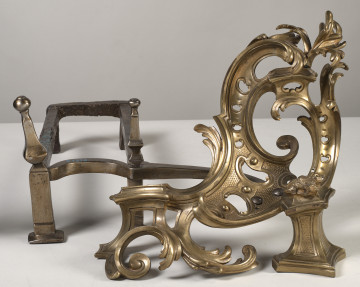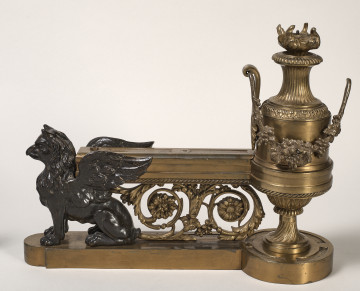
Fireplace wolf
18th century
Castle Museum in Łańcut
Part of the collection: Metale
Andiron The history of andirons, or firedogs, began in the Middle Ages, their prototype was a long rod of wrought iron with a hook for hanging a cauldron over a fire. In the 14th century, this bar was augmented by a shaft running deep into the hearth to support wooden logs, and from the 16th century on, a decorative function was added to the utilitarian function. The name “firedog” (in Poland the name “chimney wolf” was adopted) comes from English and French. The most common material used for firedogs was wrought iron, although in the late 17th century, silver and later bronze, often gilded, were common. The forms of the andirons changed with the current fashion and style, from very simple to very decorative. The andiron in question comes from the Potocki collection, from the second half of the 18th century, and is a French bronze product. The firedog consists of a rectangular-shaped grate on four legs (the back legs are arched, the front legs transform into decorative pinnacles) and a decorative part in Louis XV style, which consists of a rocaille ornament and acanthus leaves, with a cupid sitting in the middle. The cupid holds in his right hand raised the horn on which he plays. He holds a bow in his left hand lowered loosely and supported by his knee. A sash runs across the cupid’s chest – a ribbon supporting a quiver filled with arrows.
Author / creator
Dimensions
height: 29 cm, width: 47 cm
Object type
Metals
Technique
cast, forging
Material
brass, iron
Creation time / dating
Creation / finding place
Owner
Castle Museum in Łańcut
Identification number
Location / status

18th century
Castle Museum in Łańcut

19th (?) century
Castle Museum in Łańcut

18th century
Castle Museum in Łańcut
DISCOVER this TOPIC
National Museum in Szczecin
DISCOVER this PATH
Educational path